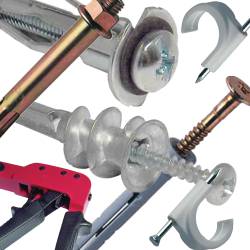A beginners guide to fixings and fasteners
The correct use of fixings and fasteners is essential in successfully completing a number of projects and applications, such as DIY and construction. Fixings and fasteners play a crucial role in the safe and secure connection of various materials, but they also provide the best chance of these connections having longevity and durability.
What are fixings and fasteners?
Fixings and fasteners are small hardware components which come in lots of different shapes, sizes and designs and which are individually suited to a large range of projects and applications. Generally speaking, fixings and fasteners are used to connect two materials together, but depending on the application they can also stabilise materials, provide balance, bear weight and absorb different levels of tension and pressure. They can be used in a wide range of possible applications from connecting small gadgets to assembling large industrial structures.
Where can fixings and fasteners be used?
Common uses for fixings and fasteners include:
DIY – Often furniture assembly, such as flat-pack beds, tables, chairs, cabinets, shelves, sofas etc, but also for garden projects such as fencing and decking. In these cases you are mainly dealing with connecting wood pieces together.
Building construction – When constructing properties you will use fixings and fasteners for connecting beams, frames and other structural elements, as well as external features such as guttering, pipework, fascias and soffits etc.
Automotive – Vehicle components are extensively connected using various fixings and fasteners.
Manufacturing – Machinery and equipment in production lines are assembled and maintained using fixings and fasteners.
Plumbing – Pipework, fittings and assemblies are connected together using fixings and fasteners.
Types of fixings and fasteners
It can be difficult to know where to start when choosing the right fixing and fastener for your particular application, so here we have put together a brief description of the most common types, how they are used and why they are different from each other.
Screws – A screw is usually driven into a material using a tool called a screwdriver, or sometimes using an Allen key. Although screws can differ in size, length and material they almost always have the same four features – a head, a thread, a shaft and an end. The thread and the point/end are the key features in terms of how the screw is driven into a material. For example, a wood screw has a pointed end and an even thread so that it pierces the wood piece without damaging it and grips onto the fibres of the wood grain to create a strong hold. Screws are used to join wood, metal or plastic and are the most versatile fixing and fastener available.
Nuts & Bolts – Bolts are similar in design to screws, but are larger in length and diameter and are usually used for more heavy duty applications, such as construction and automotive. Bolts are usually used in conjunction with a second component called a nut. This will be inserted over the bolt’s shaft to provide stability and hold. Sometimes bolts can have extra features like a hook or an anchor and can be used in more specific applications such as in masonry. As described above, nuts are metal rings which can be hexagonal, square or wing nuts, and which are placed over a bolt and tightened to help with strength and stability, often using a spanner.
Washers – These are thin flat discs with a hole in the centre and are placed over the screw or bolt assembly and between that and the surface being attached to. The washer helps to distribute load and pressure and prevent damage, and therefore provides strength and stability, particularly where a material or connection may vibrate. A washer can be metal, rubber or plastic.
Nails – The nail is possibly the simplest type of fixing and fastener in its design. A nail typically has a flat head and sharp point, this is so that it can be inserted into two materials to join them together – usually wood - using a hammer.
How to select the right type of fixing and fastener
Choosing the right screw or bolt for an application might feel like a minefield, but there are some common considerations you should make to ease this process:
Material – Is the screw, bolt or nail compatible with the materials you are attempting to connect?
Size and length – Choose a size and length that will provide the strength and durability you need. With a wood screw, for example, the length doesn’t want to be too long that it comes out of the end of the piece being joined. This looks bad and the sharp point can cause an accident. However, don’t choose a screw that is too short and which won’t provide the strength of hold that you need. With a bolt, don’t choose a length that isn’t long enough to securely fit a nut over the end. Likewise, in terms of diameter, for a heavy duty application you will need a bigger and stronger diameter.
Load requirements – Can the size and length of the fixing or fastener withstand the load requirements of the application? Do you need a bolt, nut and washer assembly and is this practical for the pieces being joined together?
Location – Where is the application going to be stored or located? If it is outside then you need stainless steel fasteners which won’t corrode in wet conditions, or which can withstand chemical exposure. For internal applications, you can choose brass screws which have a more aesthetic appeal.
Check out our range of fixings and fasteners at MB Direct and order your requirements online today, and if you need advice or recommendations on the right fixings and fasteners for your application, then contact our experts and we can help you order the right type.